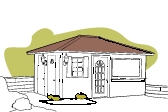
Hip roofs (or hipped roofs) are very popular in Australia. Hip roofs also often have shady eaves, and offer strength, and excellent resistance to strong winds.

What is a hip roof?
A hip (or hipped) roof is one that meets all of the walls it connects to with a horizontal join. On a rectangular building, it is likely that each of the four sides of a hip roof will have the same pitch, making the roof a symmetrical structure.
The hip roof also tends to have eaves (that is, the roof overextends past the walls), and as the fascia is at the one level height, the gutters run in a continuous piece around the entire structure. A hip roof on a square building will resemble a pyramid, whereas on a rectangular building, the different parts meet in a ridge at the top of the roof.
Why are hip roofs popular?
Hip roofs are very popular in Australia. A common alternative to the hip roof is the gabled roof, which tend to be cheaper and easier to construct. The hip roof however, has three elements which helps to make the style an Australian favourite:
- Eaves – The deep eaves of a hip roof can help to shade windows (and therefore interiors) from the strong Australian sunlight. This improves passive cooling and reduces energy bills and power consumption.
- Strength – The typical pitch of a hip roof is also better able to resist strong winds than other types of roofs, making it ideal for Australia’s many strong wind and cyclone-prone regions. For this reason, hip roofs may be more durable than other roof types.
- Style – Hip roofs have a solid, heavy appearance, which appeals to many Australian home builders and buyers.
What types of hip roofs are there?
There are many different variations on the basic ‘hip roof’ design, created mostly to suit different styles of house. Below are a few of the more common ones:
- Hip and valley – The hip and valley roof is found on buildings that are (for example) L-shaped instead of being perfectly rectangular or square. The hips and valleys on a hip and valley roof describe the points where the different parts of the roof meet.
- Broken hip and valley – A broken hip and valley roof is the same as a hip and valley roof, except that the roof is not level – some ridges and points are higher than others.
- Belcote – The belcote hip roof has a verandah attached that runs all the way around its perimeter.
What can hip roofs be made from?
Hip roofs tend to be made from metal (usually steel in Australia), or terracotta or concrete tiles. Other materials can be used, however these are the most popular.
|
Advantages
|
Disadvantages
|





